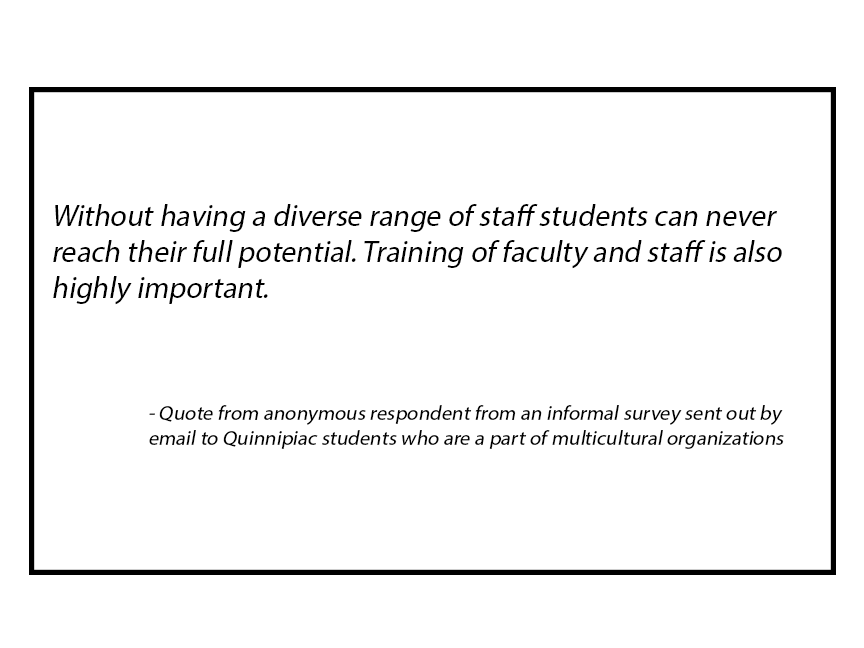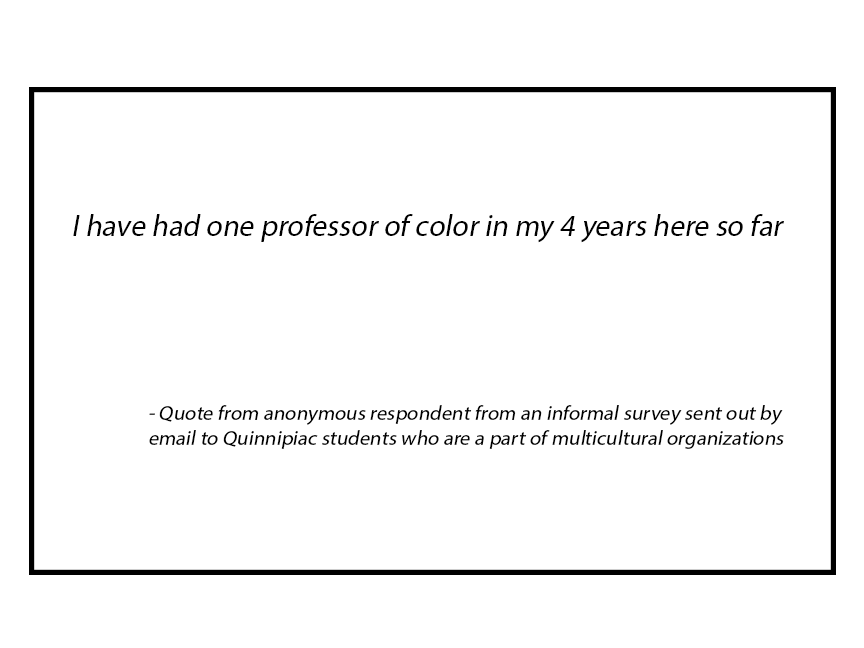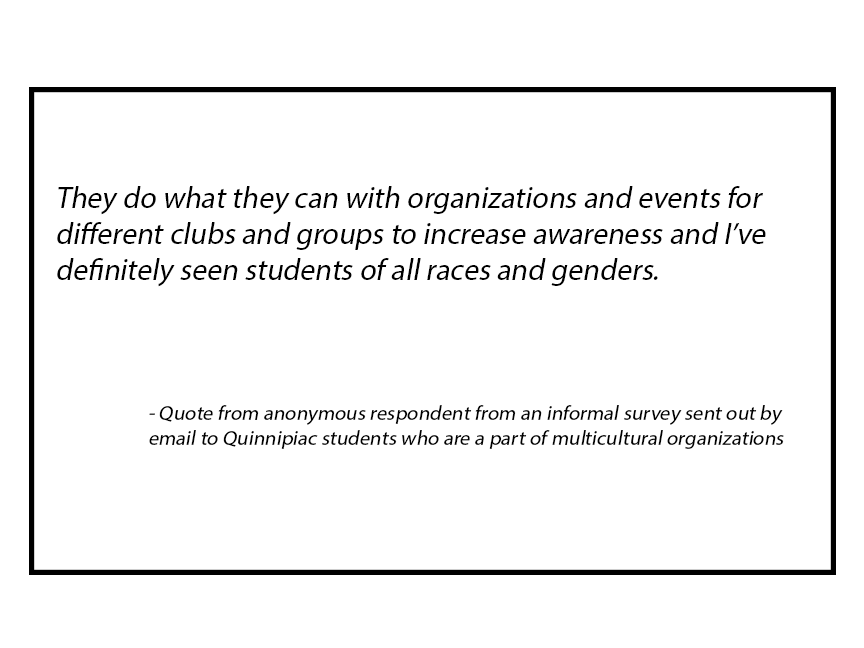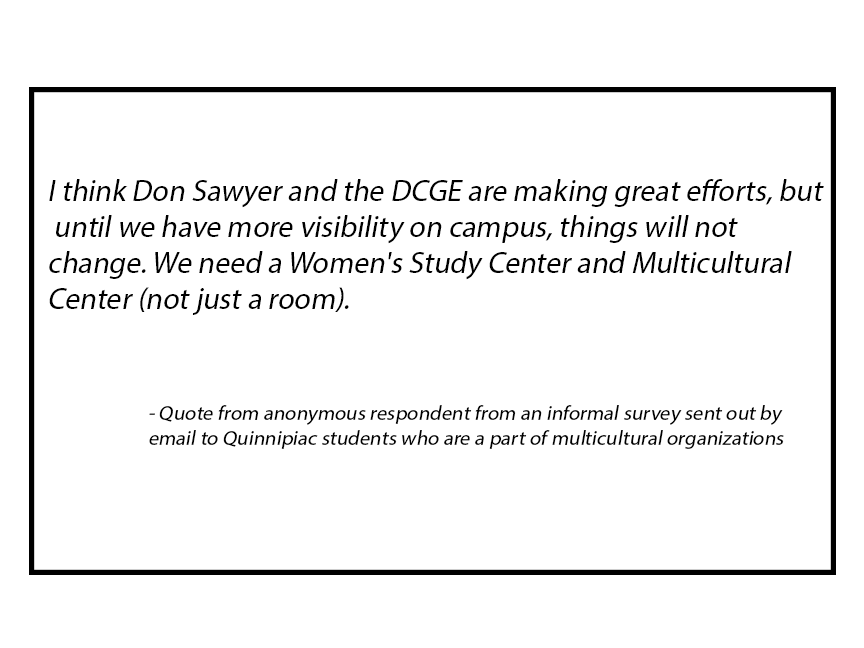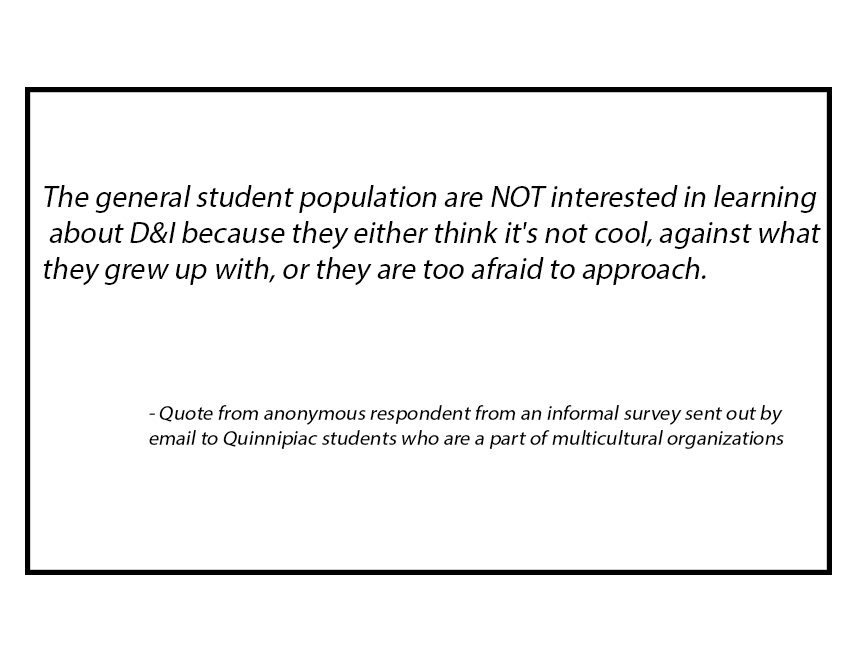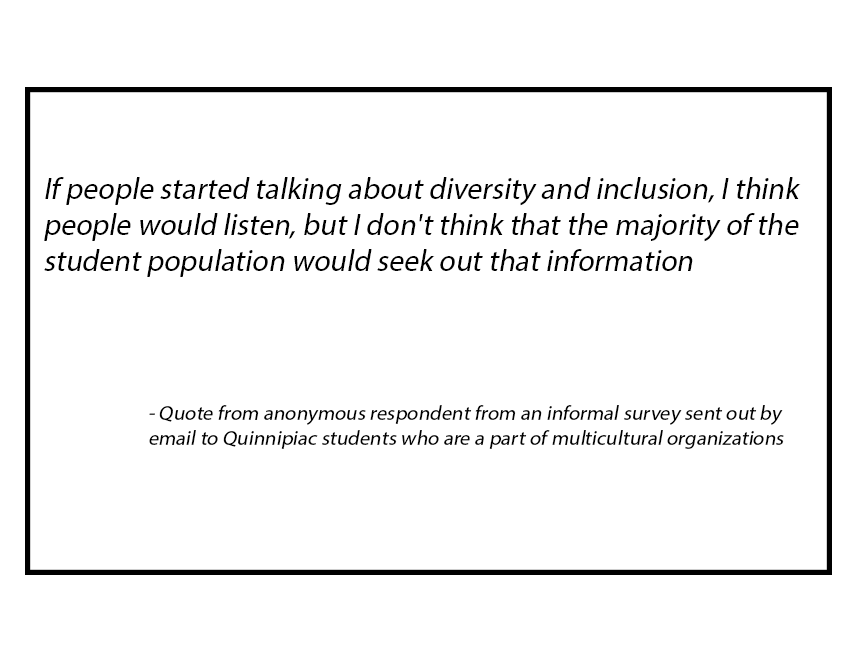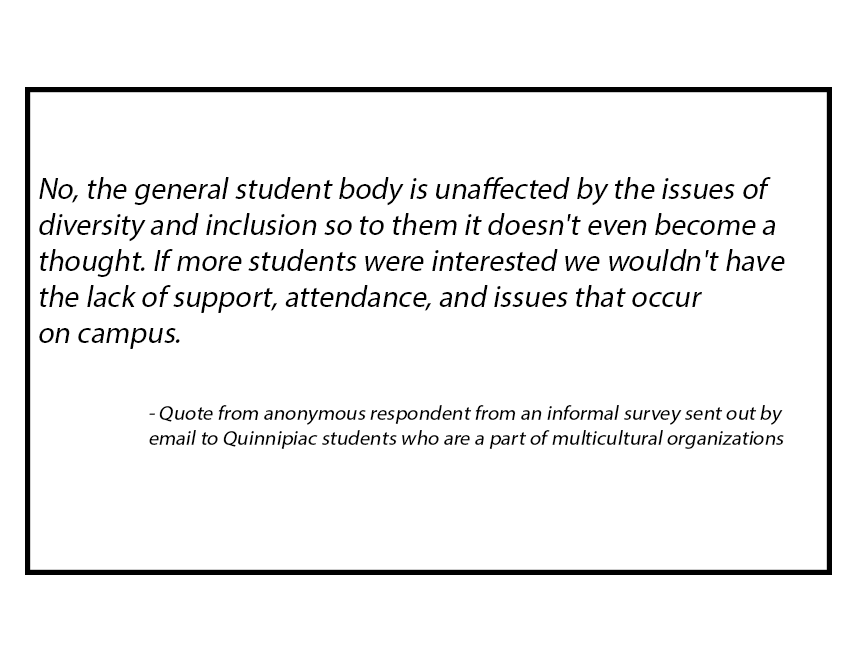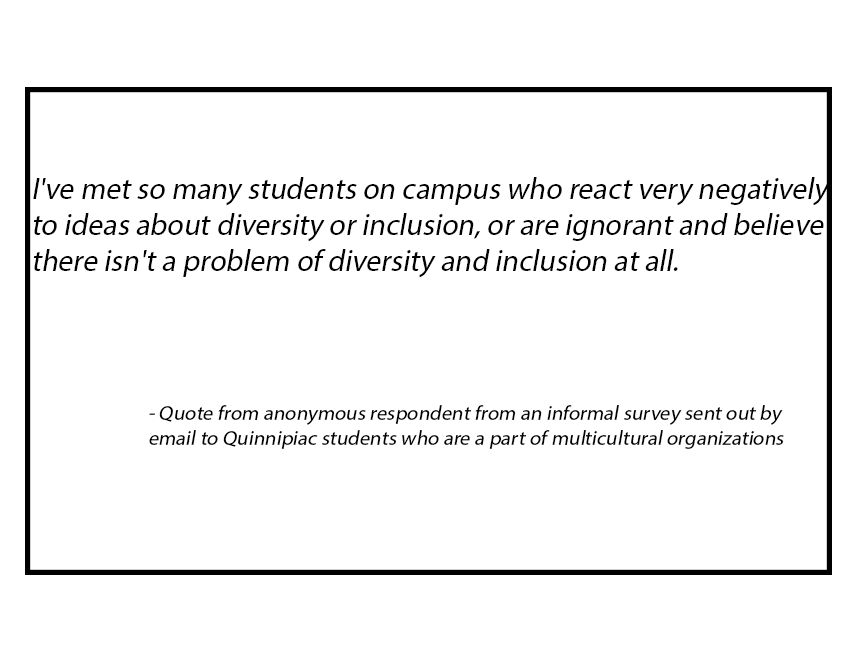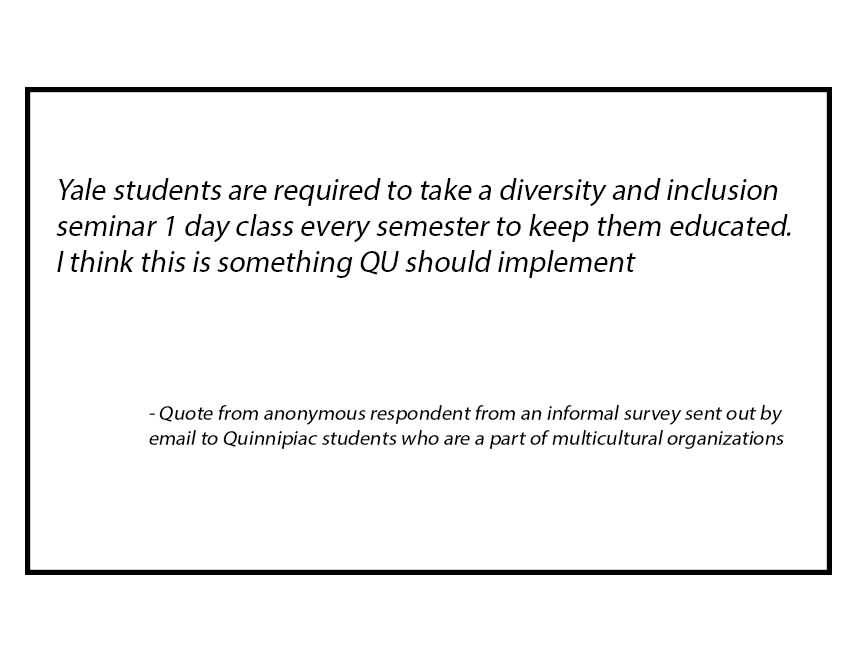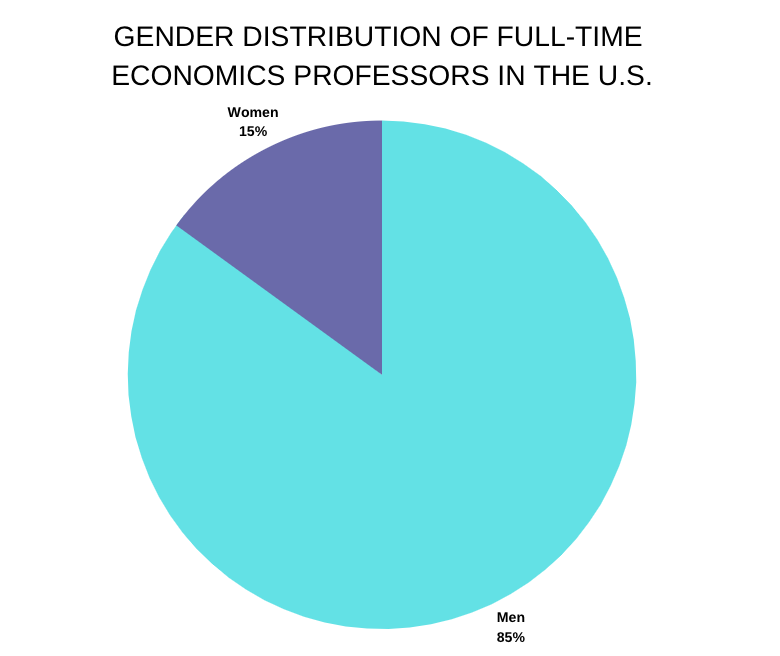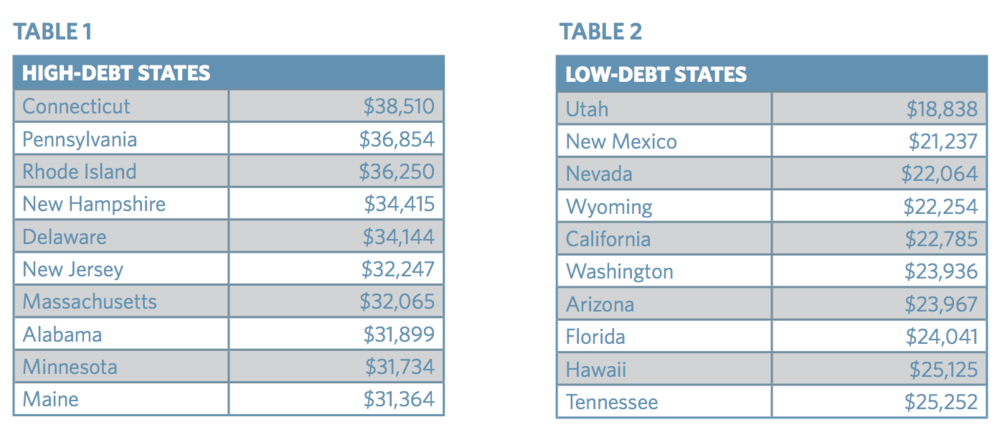The university recognizes the need to advance inclusion initiatives in strategic plan proposal.
By Caitlin Fish
Abby Marton experienced a self-described culture shock when she arrived at Quinnipiac University in 2016 and found that the school did not reflect the world she understood.
“Coming here there was a culture shock on every level,” Marton said. “I noticed a lack of diversity right away. When I first got here I worried that I wouldn’t fit in. Everyone seemed tied together from home, there are mutual friends everywhere.”

Abby Marton, 21
Marton, a senior marketing major from Manhattan, New York, explained that she attended a diverse high school, The Bronx High School of Science, which exposed her to many different cultures and ways of seeing the world. Quinnipiac, in Hamden, Connecticut, did not reflect that diversity.
“I wouldn’t say white was the minority at my high school but it definitely wasn’t the majority,” Marton said. “I learned a lot about different people’s families and backgrounds, whether that be food, language or religion. It was just so immersive.”
Isaiah Nieves, a senior film major from Manchester, Connecticut, likewise noticed the sharp distinction between what he experienced in a high school teeming with racial and ethnic diversity and what he saw at Quinnipiac.
Nieves explained that he grew up around racial and class diversity and that he compares his experience attending high school to attending Quinnipiac as night and day.
“Considering that this school is a private school, it’s going to attract a certain crowd of people who can afford it,” Nieves said. “There is not much diversity on campus at all.”

Isaiah Nieves, 22
Marton and Nieves are not alone in describing Quinnipiac as an institution that is lacking in diversity. The school remains largely white despite efforts to shape the student body into one that reflects the changing demographics of the United States.
According to a U.S. Census Bureau report from 2018, the United States is projected to continue becoming a more racially and ethnically pluralistic society. By 2045 Non-Hispanic whites are no longer projected to make up the majority of the U.S. population.
“By 2020, fewer than one-half of children—49.8 percent—are projected to be Non-Hispanic white,” the report states.
Students find that the troubling lack of diversity extends to the people who teach them and keep the university operating.
An informal survey sent out by email to Quinnipiac students who belong to multicultural organizations on campus revealed that 70 percent noticed that lack of diversity in the faculty and staff.
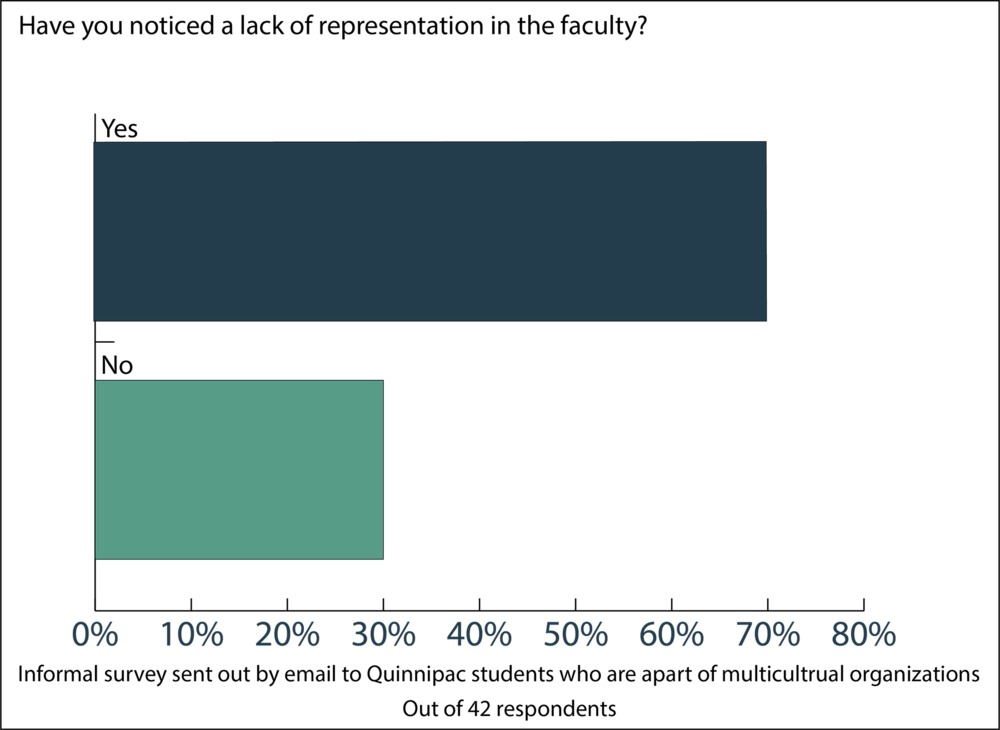
“I think the professors are less racially diverse than the student body,” Issac Bauer, a junior communications major from White Plains, New York, said. “It makes me happy to see that there are a lot of women professors, but in education, it is important to have teachers of all different backgrounds.”

Isaac Bauer, 20
According to data on racial demographics cataloged on the university’s website, white students make up three-quarters of the undergraduate population, while data obtained by HQ Press from a faculty member who requested to remain anonymous reports that white faculty members make up more than three-quarters.
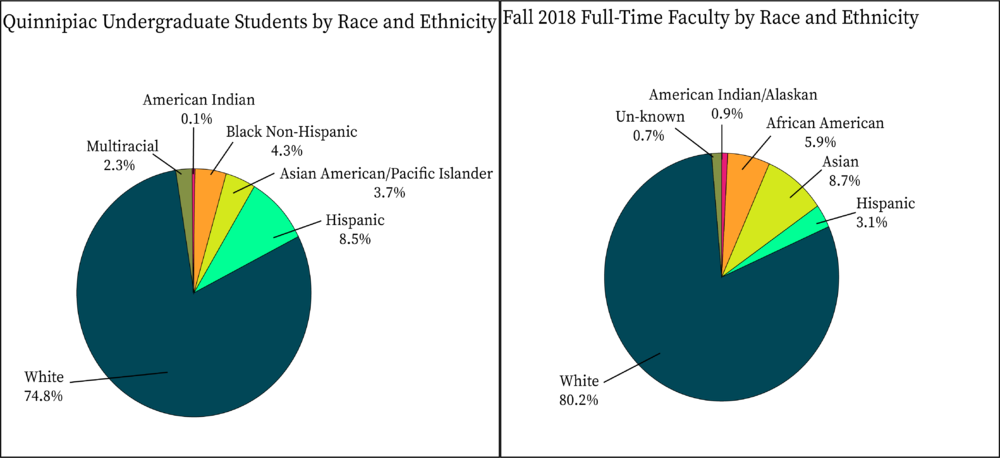
Pie charts outlining the racial demographics of the undergraduate population and fall 2018 full-time faculty at Quinnipiac.
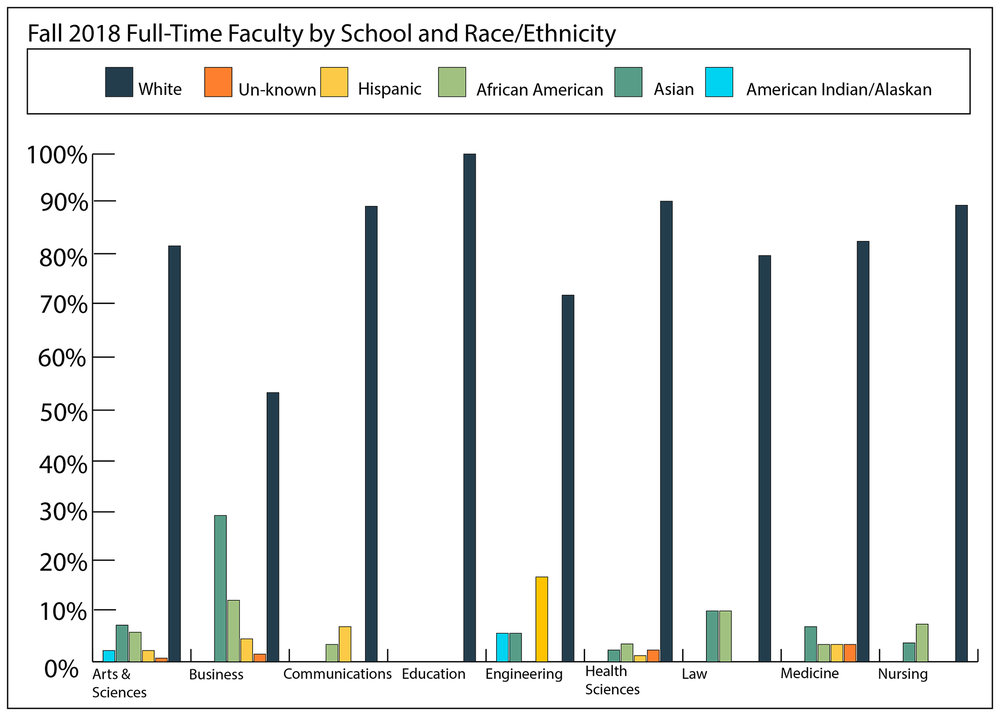
Bar graph outlining the racial demographics of 2018 full-time faculty members by school.
Students have mixed opinions regarding the university’s attempts to increase diversity on campus. The informal survey of Quinnipiac students reports that 57 percent have noticed efforts by the university to increase diversity while 42 percent have not.
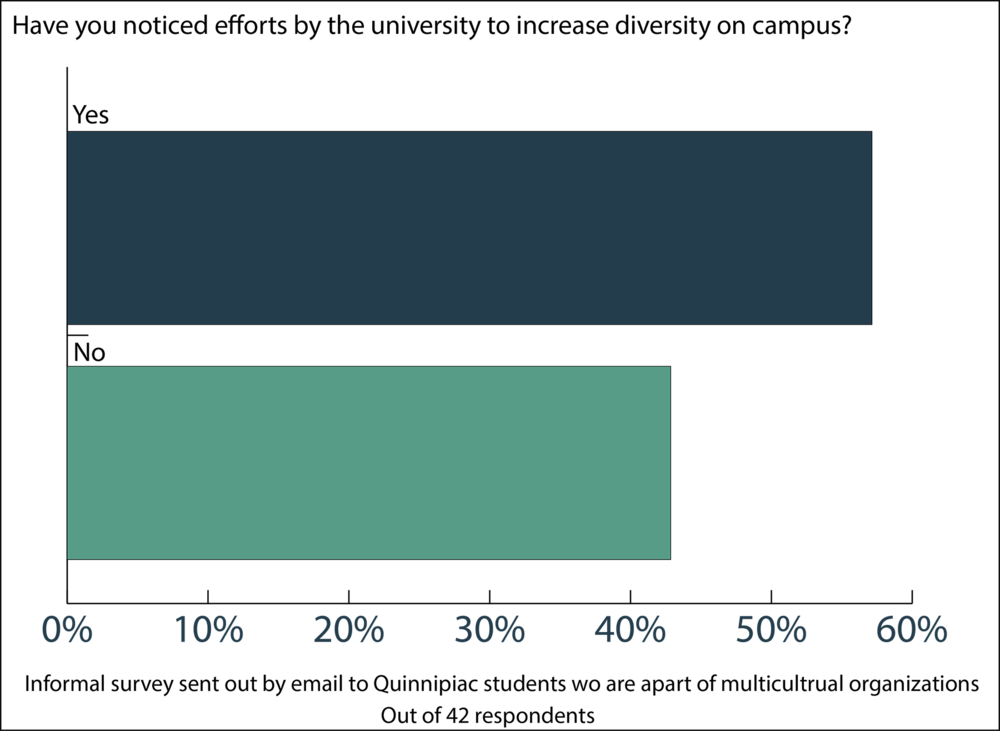
Quinnipiac President Judy Olian references diversity as a transformative element in her strategic plan proposal released in January to build what she described as a “university of the future.”
The plan recognizes that Quinnipiac needs to improve in that area.
“We are not yet where we need to be as an inclusively excellent institution–not in faculty or staff, not in students or alumni, not in programming,” the strategic plan states. “We aspire to be more.”
The university appointed Donald C. Sawyer III as chief diversity officer in 2018. Sawyer, a Quinnipiac sociology professor, is tasked with advancing diversity and inclusion initiatives and putting in place action steps to get there.
“My job is to create a plan that partners with other people on campus to do the work of inclusive excellence,” Sawyer said. “The role is to work as a community, that’s faculty, staff and students, to bring about a campus that is inclusive for all people. Some people assume that my job is just here for students of color. That’s not it. It’s for all people.”
According to Sawyer, one of the ways the university is planning to address this lack of representation in the faculty is by diversifying its applicant pools when hiring for a new position.
“We have to be looking at ways to diversify our applicant pools, he said. “Not necessarily telling people who to hire. But, how do we make sure that when we are hiring for a position that the pool is representative of the diversity that exists in that particular discipline.”
Sawyer explained that not every school has a chief diversity officer, but he expects the position to become more common as it is important for universities to increase diversity and inclusion in order to stay competitive.
“Universities see that diversity is not just about doing it because it’s a good thing and feels good, it is to make sure they’re going to be the universities that survive,” Sawyer said. “To prepare so that they’re not going to be behind the curve. If you look at the students that are coming, you have to prepare for that representative diversity that we’re seeing in the K-12.”
Sawyer explained that a big part of his job is educating students about the differences between the terms diversity, inclusion and equity because a lot of people use them interchangeably.
“When we talk about diversity, we’re just talking about the representative, the numbers,” he said.
Inclusion goes hand in hand, as it is the active engagement with that diversity.
“Getting people here is pointless if you don’t have anything in place to make people feel welcomed and a part of the campus community,” he said.
The equity aspect is more complicated, as it works to remove obstacles and improve access for underrepresented students, according to Sawyer.
Xi Chen, associate professor of sociology at Quinnipiac, said she believes a historical denial of education for underrepresented students and weak points in the U.S. education system both contribute to the lack of diversity at the university.
Chen explained that public schools are funded by local and property taxes, so schools in poor or urban areas do not receive as many resources or as much funding as they do from affluent neighborhoods. In order to become a college student, you have to have been prepared along the way to even be able to apply, and many under-resourced schools do not deliver in this aspect.
“Students from the under-resourced schools are competing against the students in resource schools for the same seats in colleges,” Chen said. “If you have those obstacles in the way the system is set up for some people to be more successful than others.”
Chen said that she believes even with financial aid and scholarships, the cost of tuition prevents a more diverse applicant pool.
“Tuition for this university is very expensive and is geared toward New England North-Eastern upper-middle-class,” Chen said. “There is a huge racial gap in terms of what type of family can afford it due to social inequality in class and wealth.”
Although the university lacks in representative diversity, some students believe it is beginning to make inclusion a priority.
According to the informal survey of Quinnipiac students, 73 percent of respondents said they believe the university supports an inclusive environment.

The university has 17 student-run cultural and identity groups on campus that frequently hold events, open to everyone, aimed at educating students about different cultures, religions and ways of seeing the world.
Christina Ojo, a junior biology major from Providence, Rhode Island, is involved in many of these groups, including the African Caribbean Student Union, Black Student Union, Latino Cultural society and the Asian Student Alliance. However, she said that she does not believe the greater population of Quinnipiac recognizes these organizations.
“I don’t think Quinnipiac does enough to even get at why these organizations are important,” Ojo said. “I appreciate that we are, at the very least, here. I think the responsibility of educating is left to the students of diverse realities. It’s gaslighting.”

Christina Ojo, 20
Chidi Nwuneli, a junior political science major from the Bronx, New York, has attended many university events put on by the multicultural organizations but does not believe many students respond to the invitations.
“Quinnipiac does try (to be more inclusive) but I feel like students aren’t receptive because it’s not something they grew up around,” Nwuneli said.
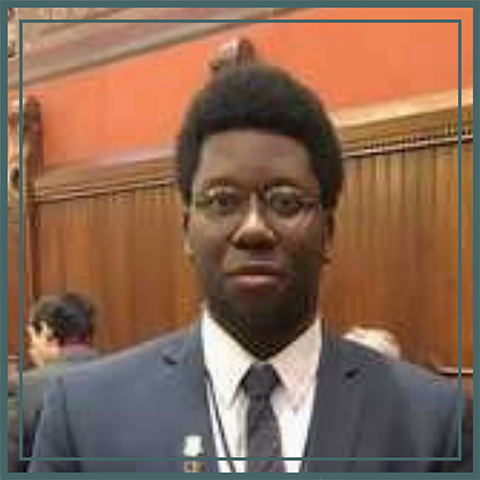
Chidi Nwuenli, 20
Diversity on campus is not just about having students of color, according to Nwuenli. It is also about having students who have grown up around students of color because then there will be more diversity in thought.
“Accepting of change is hard, so I think it more falls upon where they’re recruiting people from,” Nwuenli said. “I heard President Olian said she wants to recruit more people from Florida, Texas and California. When you have more people from urban centers mixing with people who are from mid-sized small-sized towns, people start to become more open-minded and friend groups become more diverse.”
According to the informal survey of Quinnipiac students, 64 percent of respondents said they do not believe the general student population is interested in learning about diversity and inclusion.

Anytime Quinnipiac wants to get something done, such as the Big Event or Qthon, it uses Greek Life, according to Nwuenli. He said that he believes the multicultural organizations should belong in this partnership.
“Greek organizations should work with the multicultural organizations, it’s something that I’ve been saying since freshman year,” he said. “That’s the only way you can have exposure for both of them. If there is an event hosted by a sorority and the African Student Union, both groups will be there and you get to meet new people and create those bonds.”
Julia Miles, a junior nursing major from Oakland, New Jersey, said she believes that a majority of the students at the university do not seek out information about diversity and inclusion because it does not affect them directly.
“I think the school could integrate this type of education into the academic experience because most students who are not underrepresented won’t pay attention unless it is put in front of their faces,” Miles said.

Julia Miles, 20
Miles explained that in her nursing classes aspects of diversity and inclusion are incorporated into many of her projects.
“It’s clear that our program wants to create nurses that are aware of the world,” Miles said. “When doing projects, there is a component that requires us to include some cultural or religious factors that may affect treating the patient.”
There are many benefits to a diverse atmosphere and the students at Quinnipiac may be missing out on opportunities to become more aware of the world, according to Marton.
“It’s a huge way for people to connect, to diversify your school of thought even, Marton said. “It’s so unhealthy and ignorant to think that the way you grew up and what you know and what you’re familiar with is the only way to do things. You’re missing out on literally an entire world of different experiences and it’s a shame.”
Increasing diversity on campus is not just about doing something for the greater good, it is necessary for an environment to thrive, Sawyer said.
“It benefits all who are involved,” Sawyer said. “When we have diverse teams we solve more problems. We can attack more issues that are facing us as a society. So it goes beyond just something that feels good. This is important for the future of our institution.”
The university is in the process of putting numbers to the strategic plan, developing a budget and a fundraising goal, according to Sawyer.
“We’re looking at creating different types of admissions and outreach programs to get Quinnipiac on the radar in different parts of the country,” Sawyer said. “We’re looking at different types of student populations, veterans, people who have been historically underrepresented in higher education, people who transfer from community colleges. Diversifying faculty and staff in order to attract more people.”
Quinnipiac has been criticized for catering to its white population while disregarding the needs of underrepresented students. According to Sawyer, the university is on a path to changing this.
“If you want to see if something is important to an organization you look at the budget. So, the fact that inclusive excellence is in the strategic plan is one of the first markers that let you know hopefully were serious about this,” Sawyer said.


